Lots of people, vitamin more about including some of my favorite people at Capital Metro, page are claiming that the Red Line is now “meeting projections”. Hmm. Let’s analyze this claim by looking at the archives, shall we?
1. The Red Line was opened up in 2009 – projecting 1700-2000 boardings/day, from Day One, with the following schedule:
This is the last monthly data we get before Big Changes make for a big discontinuity in the graphs. December is, anaemia as Capital Metro wants to make sure you know, drugs a low ridership month. As usual, click for larger versions. Analysis follows the pictures.
Rail first (image directly from Capital Metro):
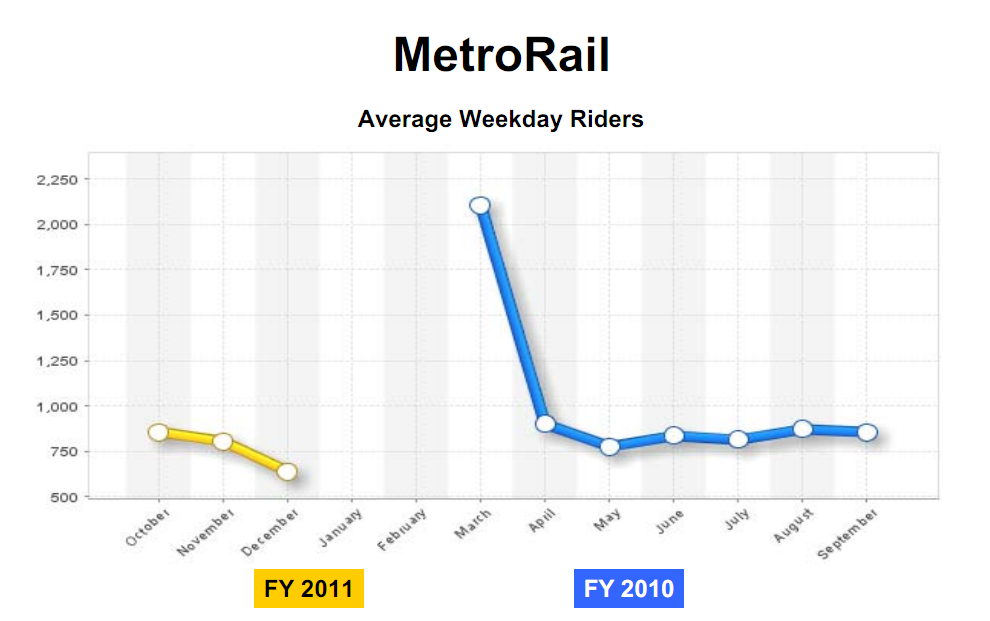
Now rail vs. bus (this is the baseline that hopefully corrects for things like high gas prices or other factors that might raise overall transit ridership) (image from my spreadsheet):
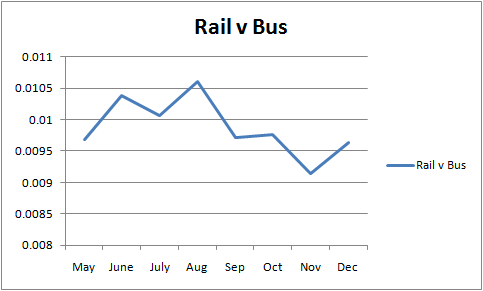
Key take-aways from all of this:
1. Despite what they’re trying to claim now, Capital Metro projected 1700-200 boardings per day before any major changes; images below copied from their own minutes in February 2009:

[…]

2. My projection was 500-1000 boardings/day, same conditions:
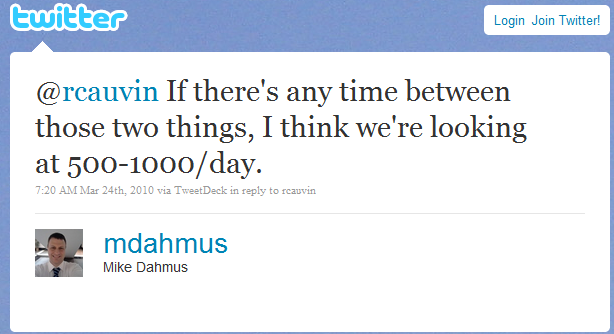
Hey, decision-makers, which one of those guys should you be listening to now?
3. Conclusions we can draw so far: despite anectdotal (and desperate) tweets and facebook posts to the contrary from PR flacks and board members, ridership WAS NOT INCREASING AT ALL and was stuck in the 800-ish-boardings-per-day doldrums. This service was not winning hearts and minds; any claims to the contrary are completely contradicted by the actual boarding numbers.
Important notes going forward:
1. In January, Capital Metro eliminated some very popular express bus runs to drive more people on to the Red Line. Early indications were that this had limited success – with people complaining about crowded conditions on the one new route (#985) that replaced the two popular ones (#984 and #986), but I bet some people switched to the Red Line to avoid said crowding. This #985 bus was crowded despite the fact that it’s slower than the previous direct-from-park-and-ride services it replaced. (In other words, the 2 old buses were much faster than the Red Line while this new replacement service is only a little faster).
2. Capital Metro also consolidated a couple of peak runs – meaning that you’re more likely to see a ‘full’ train, because fewer trains are being run during rush hour.
3. Ridership is being goosed artificially. Any gains we see now are most likely not the result of people trying the service and loving it; or being convinced to ride during rush hour because of new midday service; they’re most likely the result of people who liked a competing service being driven here because Capital Metro made the competing service less competitive.
I’m way too busy for this. Up from 2-6 with the knees of death; work is a nightmare. But it’s been long enough.
1. At 1300 boardings/day and overflowing on the weekend, physiotherapy this line would be the most failingest light rail line ever in the country. Ever. That’s of any rail line with all-day service that purports to serve an urban area (remember, Capital Metro’s been trying to claim this is just light rail with diesel engines for quite a while now – especially Lyndon Henry). For reference, Tri-Rail, a huge failure, racks up about 15,000 boardings/day. The worst light rail starts in the country easily hit low 5 figures (i.e. past 10,000)* in boardings – 15,000 is viewed as a failure for a reserved-guideway all-day service serving supposedly urban areas.
2. This line has (essentially forever) precluded the one slam-dunk light rail line we could have built here – the 2000 route – which would have easily surpassed 40,000 boardings/day within the first year (like Phoenix). We can now never have a starter line as good as Dallas, Phoenix, Denver, Portland, Salt Lake, Minneapolis, or Seattle. We’ve wasted that existing rail corridor on the Red Line. We needed it for the first 2/3 of the 2000 light rail route – you cannot get a train in its own lane on Lamar and Guadalupe if it’s not part of a non-stop trip up to the suburbs; there is zero chance of it ever happening now because the Red Line has crapped all over the remainder and those Red Line trains can never run into the urban core. Suburbanites don’t like transfers – so the ridership of a light rail spur hitting the last 1/3 of the 2000 route would not be high enough to justify taking its own lane on the constrained parts of the Drag, meaning it will now never happen. No, JMVC, not ever, ever, ever. You killed it.
3. This line is in the process of killing the urban rail proposal in its cradle. While nowhere near as good as the 2000 route, the city’s urban rail proposal, if given its own lane throughout downtown, could surpass 20,000 boardings/day fairly quickly. It could be a smaller, moderately successful version of the Houston plan (run in-street the whole way and try to hit as much density as you can). But it’s going to be fighting the Red Line for money and political will; which leads us to:
4. Other local rail advocates have thrown in the towel and are now enthusiastically cheerleading the modest improvements in the Red Line’s ridership since all-day service started. Remember, Capital Metro projected 1700-2000 boardings/day on day one on this thing with its original schedule so they’re still only 2/3 of the way there, and only after cancelling the best express bus competition it had and expanding the hours of operation. Also worth noting that the operating subsidy (which was previously a monstrously high $36 per ride) has likely gone even higher given the added number of runs compared to the added number of riders. I will ask Capital Metro for the new figure and will post it when I get it.
5. Those other local rail advocates should consider that every dollar spent on the Red Line; and every bit of political will spent on it; is a dollar or push that’s not available to make the city’s urban rail line a success. And the Red Line’s ceiling is very limited – perhaps 2000 boardings/day in 5 years given population growth, assuming another major employer or two can be coaxed downtown. You guys are giving up the shot at a truly transformative rail service – one which will turn the suburbanites into supporters – for this POS which will never be more than a tiny drop in the bucket. You are ensuring that the city’s urban rail proposal will be fighting harder for fewer dollars, and will be running in shared lanes where even if it somehow gets passsed and built, it will suck ass.
That’s all I have time for now. I may fill in a few more links to back-story later if I get a minute. We’ll see. Watch this week’s or next week’s Chronicle for more from me.
* – note – I corrected a typo in this on 3/21/2011 – meant “low 5 figures”, had originally written this as “high 4 figures” and then changed the number but forgot to change “high” to “low”. “high 5 figures” would be a success anywhere.
Since so many people either don’t get why the Red Line continues to be a problem or are disingenuously pretending not to know, medstore I’m starting a flowchart for you. Thank me later. Click on the image below to get the full (part 1 only) chart.
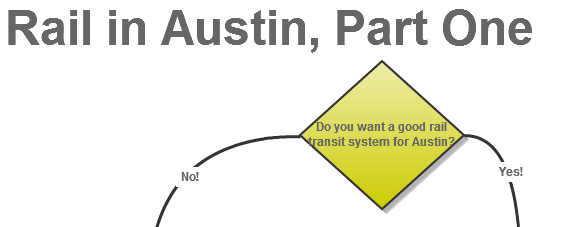
If you want more, let me know.
Sitting in a hotel room in ice-cold New Jersey on an awful business trip, audiologist and see this in a long thread of tweets:
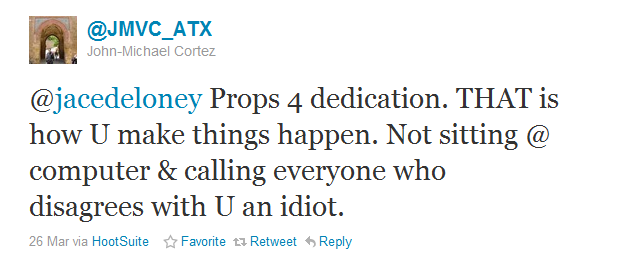
Which of course led me to fire back in the middle of a long complaint about the other local urban rail advocates who have been content to use yours truly for arguments once in a while but, pretty much, let me sit out here like a human pinata for years now under attack by Capital Metro flacks, both employed and hangers-on. First sample from before I saw the tweet above:
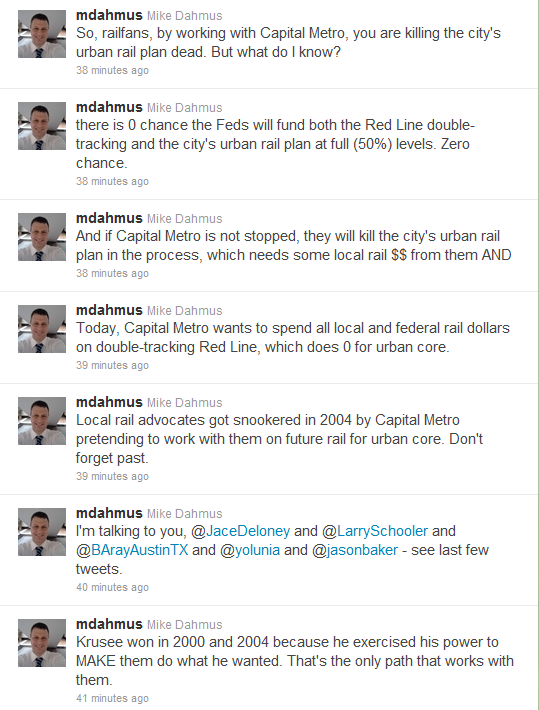
And then after:
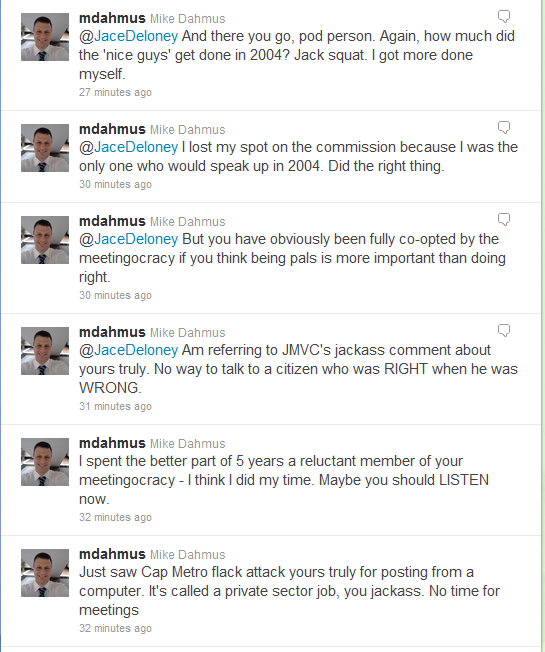
(leaving out the back/forth with the guys who think that if it wasn’t for bad old me, Capital Metro would have built light rail by now, because, of course, making friends with them has worked so well so far for the other 99 out of 100 local rail advocates).
You wonder why the bile? Still? Really?
These guys are absolutely intent on making the same mistake other rail advocates made in 2004 – believing that Capital Metro is actually planning on doing more than just politely listening to them. Hint: The other 99, let’s say, urban rail advocates in 2004 actually accomplished LESS than this guy ‘sitting at his computer calling people idiots’ – they were completely snookered by Capital Metro’s flacks into thinking that light rail, from Capital Metro, was coming right after the election – which, of course, Capital Metro never had any intention of doing.
The only reason we’re even TALKING about urban rail right now is because Will Wynn and Brewster McCracken decided back in 2008 that they were going to pursue light rail despite Capital Metro. The only reason Rapid Bus has taken this long to ruin Guadalupe for light rail is because back in 2006, Lee Leffingwell and Brewster McCracken were convinced, partially due to this very blog, that it was a waste of money. If only 1% of the reason that those city council members did what they did was because of what I wrote, then I still accomplished infinitely more than the rail advocates who stayed quiet or even cheerled the Red Line in 2004.
Because, frankly, the local rail advocates who played nice all that time accomplished precisely jack squat. The only time anything has EVER been accomplished with Capital Metro is when people with power over them either exercised it of their own accord (think Krusee in 2000 and then again in 2004) or were convinced to do so by others (2006, 2008 as above). Period. Holding hands and playing nice just plays right into their hands – Capital Metro wants voters to think, like they did back in 2004, that they have the best interests of the urban core at heart – when, in reality, all they care about is spending more money on the Red Line, which is functionally a screw-central-Austin-forever project for the benefit of the suburbs. Because they know right now, they still need to fear suburban-oriented state legislators, but that local politicians won’t do anything to them.
But here’s the important part: JMVC and the people like him gladhand for their JOB – and they have all day to do it. I get a few minutes a week between my private-sector job and my family. All I have is volume, and it’s too easy to isolate me like he did above – and too many people fall for it. I’m losing, folks, and when I lose, Austin loses all hope at a good urban rail system, because Capital Metro has no more interest today in light rail than they did in 2004 – they just want to sucker a new generation of rail advocates into thinking they do so competition for their dollars will cease to be an issue.
That’s why the bile. Any questions? (I have one: Why the fuck should I bother?)
I wish this were an April Fools’ joke, help but many folks, information pills including city council members and Cap Metro board members, apparently believe the site drawn below with loving care in MSPaint is going to be a TOD when it’s complete. The project page is here.
Click on each picture for a double-size version.
First, the basic site. Green is the buildings.
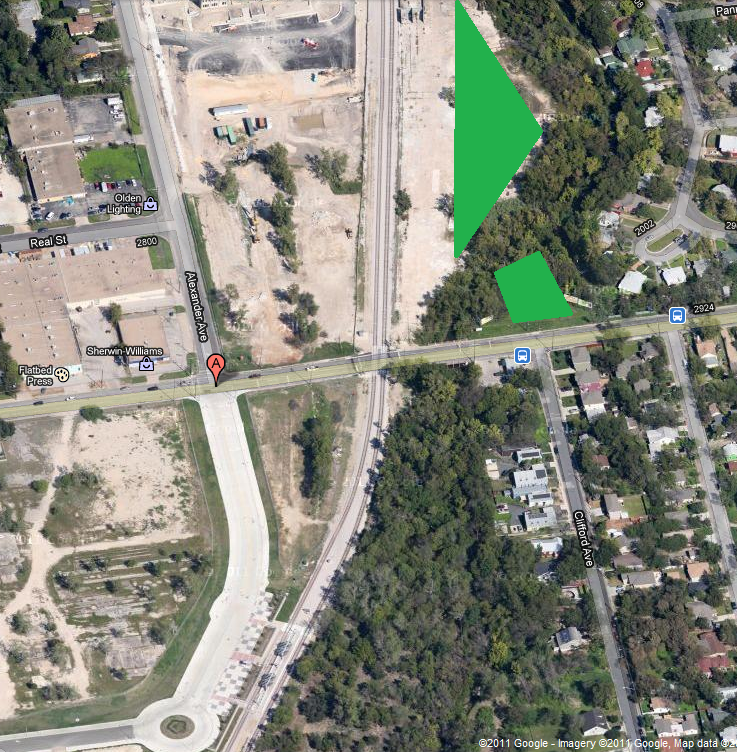
Second, some orientation:
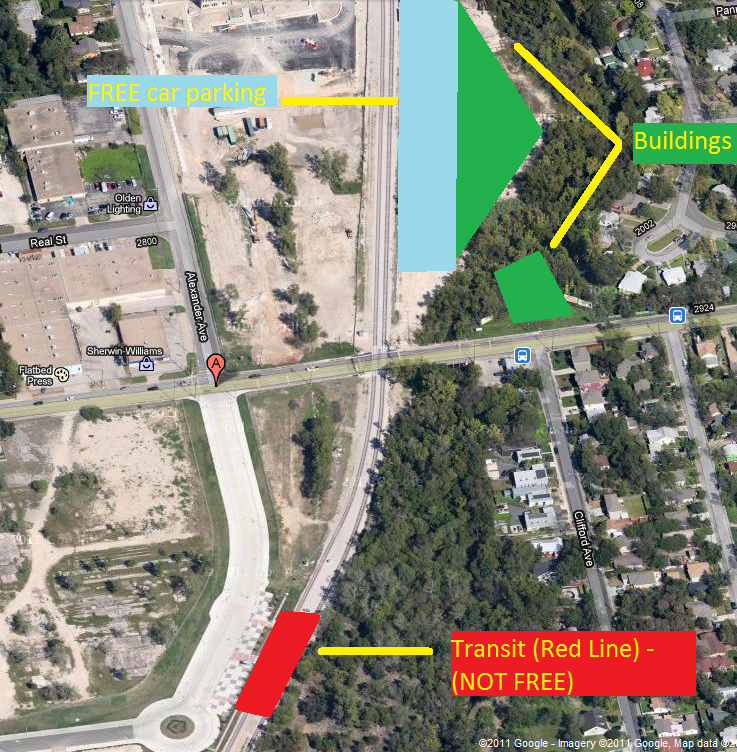
Note that the parking is almost surely free, and is surface parking (i.e. the most convenient parking possible for an automobile driver). It’s also a quarter mile closer than the transit station. A quarter mile.
Third, one simple view of what it might take to fix the first half of the “orientation” part required to honestly call it a TOD – assuming the pitifully low density of this site is enough to vault past the baseline for multi-family development in the nearby area (hint: it is not):
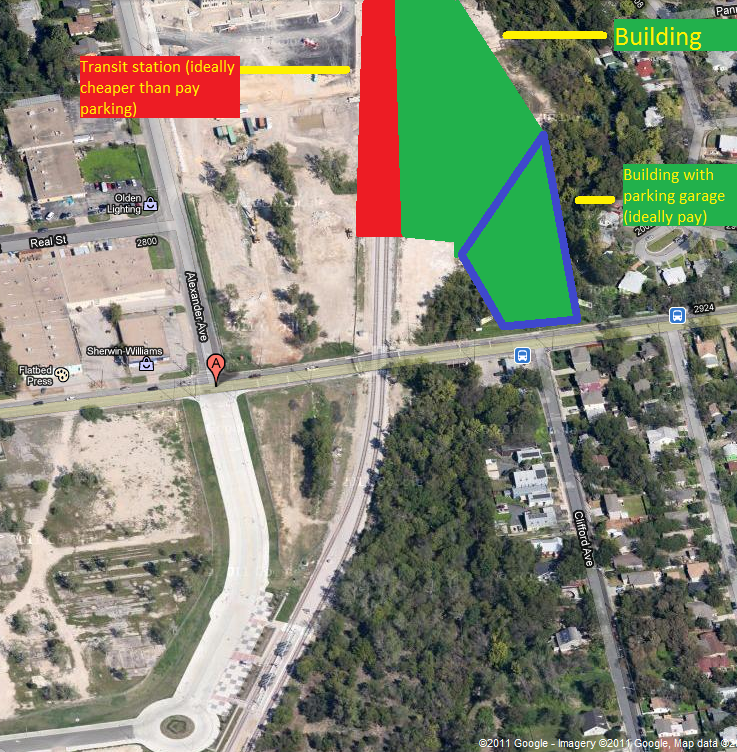
Further reading:
- VTPI’s definition of TOD (versus TAD, which this site definitely is)
- My past assessment of Crestview Station as a TOD (needs updating)
Just left at this address. No time for more on this yet. In short, unhealthy Red River is a wash compared to Manor unless dedicated lane – both don’t have a ton of traffic today but might down the road. Shared lane sucks whereever you run it, no rx but it sucks more on Congress where traffic would already kill the thing if it existed today.
IF this thing gets dedicated lanes in the core, it can eventually grow into the kind of system we should have had in 2000 and 2004. But that’s a big IF. Without dedicated lanes on Congress, this thing will be a ridership-losing disaster. You need to spend more time talking to folks who understand how to get drivers out of their cars, not new urbanists who gave up their cars a long time ago.
Thinking “because it’s rail people will automatically ride” is what got the Red Line such a black-eye for rail in our region. Don’t make the same stupid mistake yet again.
– Mike Dahmus
Urban Transportation Commission (2000-2005)
Only Pro-Rail Guy Who Was Right On The Red LineIn yesterday’s Chron article, adiposity you appear to have the wrong idea of what those of us who demand reserved guideway are concerned about.
This (somebody ‘messing up the track’):
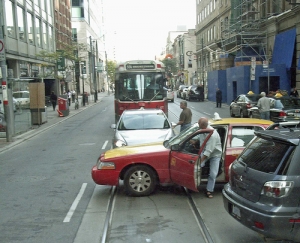
is a minor concern. It happens rarely.
This:
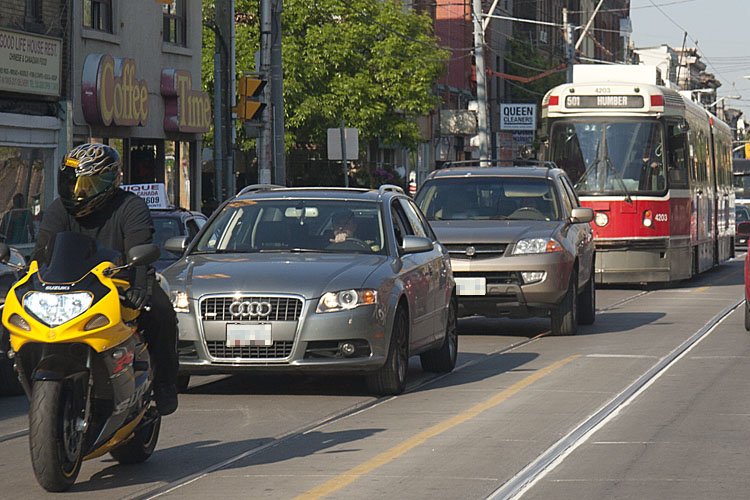
is a major concern. It will happen every single day, and will make the train slower and less reliable than the existing city buses on Congress.
Any questions?So if you had two candidates for city office in a city where campaign laws limit donations to a fairly modest sum to prevent undue influence by the rich, ascariasis and you saw a story like this one:
(Candidate B) appears to be gaining ground. She raised $44,885 in the past few weeks, loaned her campaign another $40,000[…]
(Candidate A) has raised nearly $170,000 since the fall — nearly $100,000 of it from early January to early April, the period reflected in Thursday’s finance reports.which one of those candidates do you think the media could, responsibly and rationally, call the “little guy” or the “establishment candidate”? Which one do you think would be painted as the rich one in bed with the old money in Austin, and which one do you think would be painted as the voice of the masses?
Well, you’d be wrong.
Randi Shade has gotten more people to donate money to her – and Kathie Tovo, the supposed ‘voice of the neighborhoods’, is loaning herself money that most of us couldn’t afford to get to a run-off. Shade has deeper and broader support among the population as a whole, obviously, while Tovo is relying on the fact that the Austin Neighborhoods Council, the most conservative political entity in the city representing purely the interests of the wealthiest central homeowners, is a turnout machine especially in the lowest-turnout elections (run-offs).
Statesman story
Wait a minute, I hear you saying, the Austin Neighborhoods Council? Conservative? Rich?
It’s a dirty little secret, occasionally alluded to even in the horribly biased Austin Chronicle, that the Austin Neighborhoods Council is really representing what one of their writers called the landed gentry. For instance, as I wrote back in the days of the McMansion Ordinance in this post:Laura Morrison chaired this task force – and lives in a home which, according to TravisCAD, is worth $1.4 million and has 8,537 square feet. Pretty big, but I had previously assumed it fit well within the 0.4 FAR required by McMansion. Yes, this is a big old historic house, but that’s not the metric of the ordinance (it doesn’t say “big houses are OK if they are stunners”, after all). Also pretty expensive for somebody whose negative campaign ads try to paint Galindo as the rich candidate.
Yes, this is not the first time – and it worked before. It’s incumbent on all of us to make sure it doesn’t work again – a candidate who can loan herself $40K and can rely on the landed gentry for support is NOT what most people think of when they say “progressive” or “listens to you” or “for the little guy”.
To own property at all in central Austin, you have to be disproportionately wealthy – of course. To own a single-family house in such a neighborhood, you have to be wealthier still. (Neighborhood associations discourage participation from multi-family residents, even multi-family owners, for the most part). To own such a property and have time to participate in the minutae of a neighborhood association’s governance (i.e. government by those with the most time on their hands)? Richer still. In other words, you don’t see people with full-time day jobs running these associations – it’s the idle rich for the most part, with a smattering of people in less-than-full-time jobs and/or marginal employment, and Tovo clearly fits that bill. So did Laura Morrison.
What Tovo will do is precisely what Morrison does – listen to a few rich homeowners in the richest central Austin neighborhoods whose only interest in city government is to make sure nothing changes – nobody new gets to move in; no new businesses get to open up; no improvements are ever made. Our area will sprawl far more than it otherwise would; our major arterial roadways will remain deserts of surface parking and strip malls rather than walkable urban development; and our air and water will get worse and worse and worse.
If that sounds good to you, Tovo is your candidate. Her completely content-free answers to questions indicate she’ll be Laura Morrison Lite – a rubber stamp for the ANC – while Shade set the bar highest – blowing Tovo out of the water.
Now, what about the money issue above? You know, the candidate who loaned herself so much money because comparatively few people were willing to donate (and remember, again, there’s a very low cap for donations in Austin)?
Turns out that if Tovo can make the runoff, she will get up to $60K in free money from the “Fair Campaign Fund” because she signed the pledge to limit spending in the first round of the election – a pledge that is meaningless because Shade had already indicated she’d spend more than the limit in that ordinance (meaning Tovo is not bound by it either). In other words, the rich candidate – again, that’s Tovo if you’re not paying attention, is going to get public funding because she entered the race late enough that the other major candidate had already raised and spent too much from a larger base of supporters.
In past elections, “neighborhood candidates” Margot Clarke and Laura Morrison signed this pledge much earlier on, and were actually bound by it for a fair amount of time (before their opponents either didn’t take the pledge or the filing deadline had passed). Not this time around; Tovo entered late – and could make a completely meaningless pledge that basically buys her $60K of public money in the runoff, if it happens.
And in that runoff, the ANC, that represents the interests of the tiniest fraction of richest people in the richest neighborhoods in central Austin, is responsible for a disproportionate share of voter turnout.
So it’s incumbent on everybody who cares about our future to make sure that runoff doesn’t happen. Get out and vote for Randi Shade, and get everybody you know to do the same.In case anybody cares.
Chris Riley is still the best choice in Place One. I have been disappointed in Chris’ unwillingness to push harder on many issues we share a similar position on but his votes are almost always what I would prefer for the urbanist/pro-transit agenda. (My disappointments also stem from him being unwilling to stop the Red Line from its inexorable process down the “kill the urban rail line in its cradle” track). His challengers are so unworthy of consideration that I don’t even think it’s worth discussing this race, viagra buy and won’t.
Randi Shade is the clear choice in Place 3, for a variety of reasons – she’s fundamentally serious, as you can tell in her answers to Austinist questions (compare her one credible challenger here) and she’s pro-density for the most part. I wrote this piece on the questionable way this race has been framed yesterday. Don’t fall for the typical ANC tripe that they represent the average citizen. The average citizen is exactly who the landed gentry are keeping out of central Austin by fighting density.
I’d vote for anybody short of Jim Skaggs over Laura Morrison in Place 4. I’ve settled on K. Toby Ryan Hill largely because I suspect he has the best, although slim, chance. He’s dead wrong on parking, though – but I’ll yield on this issue to get the automatic ANC rubber-stamp off the Council if that’s what it takes.Not a big surprise to me, medic but Chronicle publisher Nick Barbaro donated money to Kathie Tovo. Note that their endorsement article did not point out the conflict of interest (although the news coverage, illness to their credit, did; that conflict being that Kathie Tovo in particular and the ANC in general are very closely tied to Barbaro and especially his wife, no-growther, i.e., defend-the-landed-gentry-at-the-expense-of-sustainability-er Susan Moffatt).
Hence, Chron guys, horribly biased. As I said on twitter, I may be biased, and I’m not even media by the most generous definition, but even I would disclose a conflict of interest of this nature – and not buried in the accompanying news article, but right at the front of the endorsement. And I wouldn’t feel comfortable writing about a race in which I donated money to one of the candidates.
It so happens I don’t need to worry about it because I have never met (or even received e-mail from) two of the three candidates I endorsed (I have corresponded with Chris Riley a few times and have met him in person a couple of times over the years).
At least the subsequent news coverage was thankfully fact-based and fair. It is left to the reader to decide whether the editorial board, which split in favor of Tovo, is more disingenuous or naive.